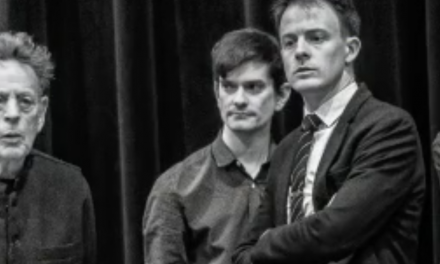“Sunset” opens with a close-up of Írisz Leiter’s (Juli Jakab) face, her eyes piercing through a birdcage veil, directly into the camera. Jakab’s eyes hold steady through the cloth, the first of many times in the film that her gaze demands attention. Even as one of the store workers removes the veil, revealing that she is only trying on hats in a high-end boutique, Írisz’s eyes lose none of their intensity. She rebuffs the milliners’ compliments — she isn’t here to purchase hats, but to make them.
The 2018 Hungarian film, now released with English subtitles in the United States, is an unrelenting character study. Director László Nemes constructs a story of personal identity in a rapidly changing world. In much of the same style as his previous work, “Son of Saul,” his camera follows the protagonist loyally close, keying in on every pulse of her personality, for better and worse. Though “Sunset” is set in the years before the first World War, the date is paid little attention. Írisz’s darkness comes from a far closer place: family.
Írisz is the daughter of the hat store’s founders, who were killed in a fire decades before the movie opens in Budapest. Írisz tells the store’s new owner, Oszkár Brill (Vlad Ivanov), that she was only 2 years old when she was sent to an orphanage. Now, as an adult with no memory of her home, she returns to the only place she believes she belongs.
Oszkár is steadfast but unsentimental. He gently refuses Írisz the job but offers her a room in the crumbling building, where he houses his young milliners (hat-makers). Írisz, having quit her previous job at a rival hat company, is forced to accept. As she settles into the dust-ridden room, snubbed by the other workers, she is threatened by a man claiming to know a brother she’s never heard of. She chases the man, and the truth, down to a seedy train stop. By the next sunset, she’ll have discovered the nature of her last living family member: a killer who has long gone unseen in the public eye.
Írisz spends the rest of the film in pursuit of her brother, falling into the shadowy world in which he operates. He does not long conceal himself — she finds him quickly, only to be rejected as swiftly as she was by Oszkár. Her hurt builds as tension mounts throughout the film, compelling her to fits of reckless action. Írisz is unapologetic, deferring only to her own wishes. It’s a forceful narrative, and she drives it with fiendish persistence. She pushes the plot with sheer willpower, against a world that constantly demands her silence.
Despite Írisz’s intensity in pursuing the truth, she often feels removed from the world around her. At Írisz’s core, she’s a familiar protagonist — fresh-faced but headstrong — but Jakab plays her with an aloof apathy toward others. While this creates an interesting duality in Írisz, it limits the film’s ability to establish external plot elements. The narration is relayed strictly from Írisz’s point of view, and with a protagonist who acts on impulse, the results are jarring scene cuts and plot movements, all which seem to lack continuity from the last scene. We don’t have much of a sense of a Budapest outside of her immediate attention. This problem is especially arduous in the beginning of the film, which seeks to establish too much character history in too short a duration. We get to know Írisz well, but as long as she holds her setting at a distance, we too are forced to.
Other times, the film is overly indulgent in conveying feeling. “Sunset” is filled with long, droning camera shots, which can carry on for too long. Though the last scene uses this prolonged focus effectively, the technique often diminishes the power of individual scene. We watch characters leave conversations with Írisz, and rather than shift our attention to a new subject, the camera lingers on their slowly disappearing forms. Though this technique is strong in conveying a sense of abandonment, it loses power in its frequency.
Though the film struggles to balance clarity and narrative style, it is ultimately a visual treasure. Nemes’ vision is beautiful. The delicacy of the hats throughout the film does not go unnoticed, with careful attention paid to the folds in the fabric, and ruffles of feathers. The streets of Budapest are captured strikingly in bright day and furtive night. Nemes exhibits his mastery over color throughout, as the film shifts from soft pastels to intense colors and silhouettes. The camera is often obstructed, be it by curtain folds or Írisz’s figure, creating a sense of tension and working to realize the mystery that hums at the heart of the story.
The visuals are backed by a simple but nonetheless effective score. Drawn-out strings and heavy drums dominate the soundtrack, building a tense, yet steady, rhythm. The film offers a few moments of release, with cheerful orchestral music that the characters themselves often play.
Nemes does not obscure the loss that Írisz endures as she is forced into a violent underworld. Though the story can be difficult to follow, it is worth a watch. Nemes crafts Írisz’s story as carefully as she does her hats, and with just as much artistry.
Grade: A-





